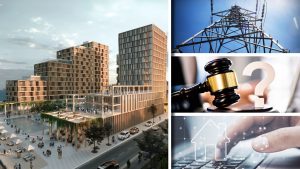Federal officials plan to start construction within weeks on a new “virtual fence” along the U.S.-Mexico border that they say could almost completely cover the nearly 2,000-mile frontier within five years.
TUCSON, Ariz.
Federal officials plan to start construction within weeks on a new “virtual fence” along the U.S.-Mexico border that they say could almost completely cover the nearly 2,000-mile frontier within five years.
The first permanent towers holding sensors, cameras and communications gear to detect drug smugglers and illegal immigrants will be built along 53 miles of Arizona’s border with Mexico, said Mark Borkowski, a Customs and Border Protection official in charge of the program.
More towers, up to 120 feet tall and spaced miles apart, will follow on the remaining 320 miles of the state’s southern border. Virtual fencing then will go up in New Mexico, followed by California and most of Texas, said Borkowski, executive director of the Homeland Security Department’s Secure Border Initiative program.
The four-legged steel towers will have 2,500-square-foot footprints. From 40 to 120 feet tall depending on terrain, they will be perched on concrete block pads inside fenced compounds, equipped with solar battery rechargers and backup generators.
“Construction should start imminently,” Borkowski said. “We’re in the final throes of convincing ourselves that the engineering is fine.”
The plans follow a prototype virtual fence that federal officials and others found inadequate for the job, and Borkowski said improvement probably will be made to the final version after border agents begin using it.
Depending on funding, the whole southwestern border except for about 200 miles around Big Bend National Park in Texas would be covered by 2014, Borkowski said. That area would also eventually be outfitted with the system.
“It’s in our list of to-dos,” Borkowski said. “It’s just such a rugged area, we think it’s the last place we need to do.”
Plans for a virtual fence on the Canadian border aren’t fully developed.
The electronic monitoring is meant to supplement pedestrian fencing and vehicle barriers that have been built along 624 miles of the southern border. About 46 more miles of fencing are planned.
Borkowski declined to estimate what the entire southwestern virtual fence project will cost, though Adam Comis, press secretary for the House Homeland Security Committee, said the cost is estimated to be about US$6.7 billion by 2014.
The primary contractor, the Boeing Co., has received about US$600 million so far for technology development on the initiative. As of a year ago, Boeing also had received some US$260 million for construction of physical border fences and vehicle barriers, primarily in Arizona and Texas.
The virtual fence is designed to use radar and cameras with about a six-mile range, including infrared devices and other technologies, to detect smuggling attempts. The sensors are designed to be able to distinguish people from animals and allow operators to direct Border Patrol agents to intruders.
A prototype virtual fence strung across 28 miles of the southern Arizona border has been in use since late 2007.
The Government Accountability Office told Congress last year the prototype fence did not fully meet expectations and its design wouldn’t be used as the basis for future developments. It is still operating, though, and its portable towers will be used in test scenarios elsewhere.
“I am hopeful that the department and its contractors have learned from previous failed attempts and will apply those lessons to the deployment (of the new system). We will be watching closely until SBInet is complete,” Rep. Bennie Thompson, D-Miss., chairman of the House Homeland Security Committee and a critic of the initial virtual fence efforts, said via e-mail Thursday.
The decision to move forward with construction was met with caution by a border security advocacy group.
“They’ve spent a lot of money and time on one (virtual fence) that didn’t work very well, so there’s reason to be skeptical,” said Ira Mehlman, a spokesman for the Federation for American Immigration Reform. He said the high-tech devices aren’t a substitute for the promised actual fencing.
Borkowski said he expects changes will be made to the system as it is built, noting that its primary user — the Border Patrol — had only a small role in designing it.
“We actually want the Border Patrol to use this system and gain experience and then to tell us what they want us to add to the system,” he said.
When the prototype system came under criticism, Homeland Security and Boeing officials emphasized that it was built with off-the-shelf equipment to demonstrate that the concept would work, and acknowledged that the components proved less than ideal.
Associated Press









Recent Comments
comments for this post are closed